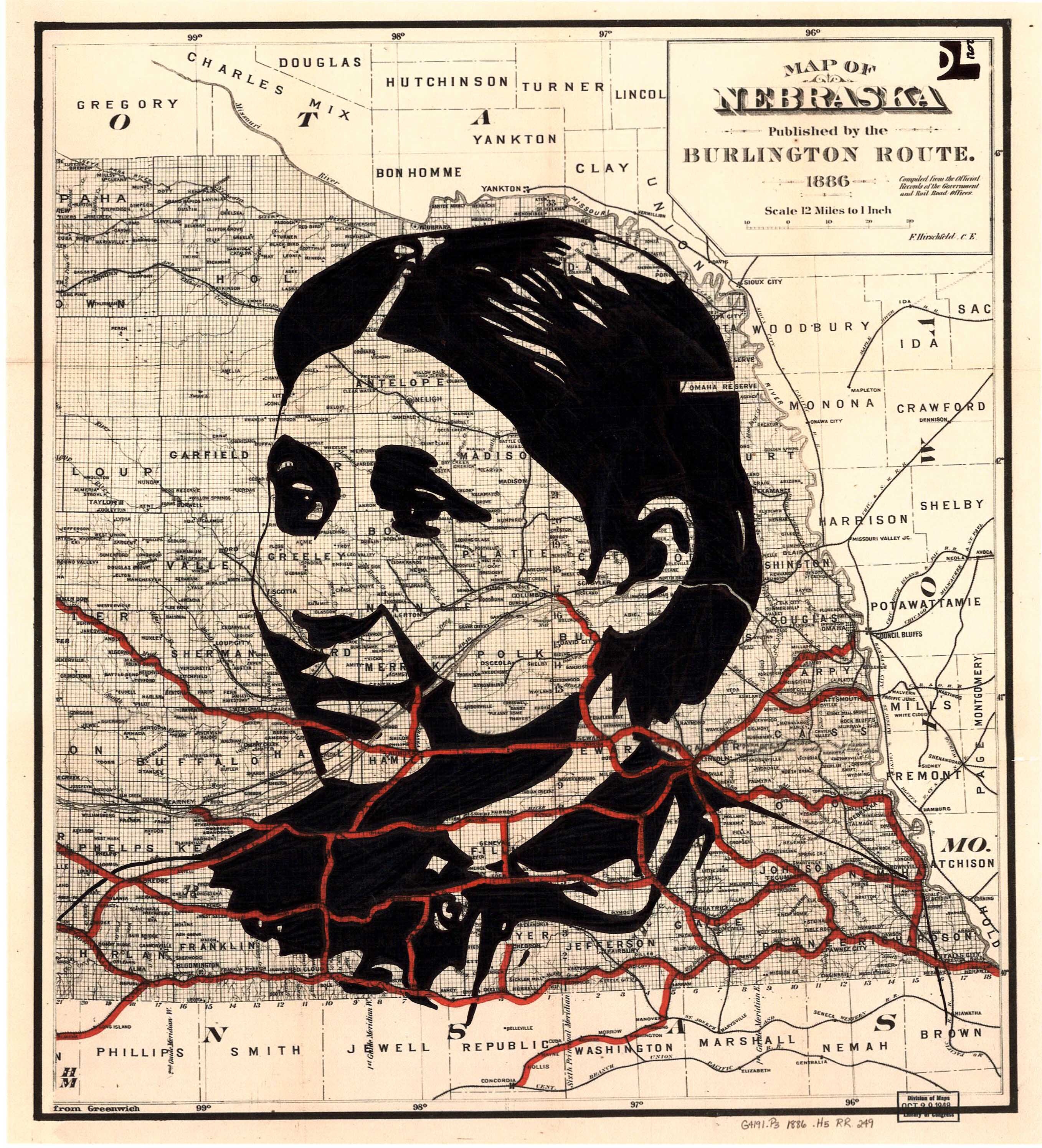
Tuesday Apr 19, 2022
Dr. Susan La Flesche Picotte: First Native American to earn a medical degree
“My office hours are any and all hours of the day and night.”
Dr. Susan La Flesche Picotte
First Native American to earn a medical degree

The Artwork:
Picotte’s portrait in the Fearless Portrait project consists of an Ink drawing of her n an 1886 map of Nebraska; the Omaha Reservation is marked on top right side of her head. The portrait is based on one of the few photographs that exist of Picotte.
The Story:
The winter of 1891 was bitterly cold on the Omaha Reservation in Nebraska, with temps diving to 20 degrees below zero. The cold wasn’t going to stop Dr. Susan La Flesche Picotte from making a house call for a young girl taken gravely ill from the influenza outbreak wreaking havoc in the area.
For the next two weeks, Picotte would visit her patient constantly, spend nights at the girl’s bedside and even cook meals for the family. When the girl eventually died, Picotte was by her side. Such was her dedication to her patients. The sole doctor on the 1,350 square mile reservation, Picotte was responsible for all 1,300 residents.
As a young girl herself, Picotte watched an elderly Omaha woman die because a white doctor refused to come and help. Four times he was summoned; four times he said he’d be there soon. He never came and the woman died just after sunrise. Picotte said later, “It was only an Indian and it did not matter. The doctor preferred hunting for prairie chickens rather than visiting poor, suffering humanity.”
The incident haunted Picotte for the rest of her life and spurred her to do what she could to make sure that never happened again.
It was uncommon for women in the US at that time to go to medical school. Undeterred, Picotte enrolled at the Woman’s Medical College of Pennsylvania—one of the few schools that accepted women. After a three-year course of study, Picotte graduated as valedictorian in 1889, becoming the first female Native American to earn a medical degree in the US.
After graduation, she returned home to the Omaha Reservation and took the position of physician at the government boarding school there run by the Office of Indian Affairs. While technically responsible only for the students’ health, as the only doctor around, her people relied heavily on her for medical care, as well counsel around legal, finance, and political issues. She often worked 20-hour days, seeing patients at her clinic and making house calls. As she described it, “my office hours are any and all hours of the day and night.”
She toiled for years this way, on a $500 government salary and a $250 medical missionary stipend (equal to nearly $22,000 in 2020).
Background on La Fleshe Picotte
Picotte’s father, Joseph La Flesche, also known as Iron Eyes, was the last recognized chief of the Omaha. He sought to help his people by advocating a level of assimilation. He encouraged his children to pursue education. Born on June 17, 1865 during the buffalo hunt in a remote area of the Omaha reservation, Picotte served as a bridge between her traditional society and the encroaching White American culture.
In 1894, she married Henry Picotte and they had two sons. Going against Victorian-era expectations for married women, she continued practicing medicine.
Always dedicated to the health of the Omahas, she dreamed of building a hospital on the reservation. By 1913, raised the funds to open Walthill Hospital in 1913. As a single, widowed woman, building and staffing a modern hospital without any government assistance was an unheard-of achievement. After her death in 1915, the facility was renamed in her honor.
Music:
This episode contains music by Geovane Bruno and the Library of Congress’ Omaha Music Collection.
Sources:
- Changing the Face of Medicine. (n.d.). Changing the Face of Medicine | Susan La Flesche Picotte. NIH. https://cfmedicine.nlm.nih.gov/physicians/biography_253.html
- Friedman, M. (n.d.). Inflation Calculator. Westegg. https://westegg.com/inflation/infl.cgi?money=750&first=1890&final=2020
- Kettler, S. (2020, October 30). 5 Powerful and Influential Native American Women. Biography. https://www.biography.com/.amp/news/famous-native-american-women-native-american-heritage-month
- Nebraska Studies. (n.d.). Susan La Flesche Picotte First N.A. Female Physician. http://www.nebraskastudies.org/en/1875-1899/susan-la-flesche-picotte-first-na-female-physician/
- Nusbaum, J. (2019, June 5). AMPLIFY: Dr. Susan La Flesche Picotte. HerStry. https://herstryblg.com/amplify/2018/8/23/amplify-dr-susan-la-flesche-picotte
- Quote Catalog. (n.d.). Best Susan La Flesche Picotte Quotes | Quote Catalog. https://quotecatalog.com/communicator/susan-la-flesche-picotte
- Tague, T. (2020, October 5). Against the Current: The Legacy of Susan LaFleshe Picotte. Nations Media. https://nationsmedia.org/susan-lafleshe-picotte/
- Vaughan, C. (2017, March 1). The Incredible Legacy of Susan La Flesche, the First Native American to Earn a Medical Degree. Smithsonian Magazine. https://www.smithsonianmag.com/history/incredible-legacy-susan-la-flesche-first-native-american-earn-medical-degree-180962332/
- Wikipedia contributors. (2022, March 29). Susan La Flesche Picotte. Wikipedia. https://en.wikipedia.org/wiki/Susan_La_Flesche_Picotte
- Wilcox-Lee, N. (2016, November 6). Susan La Flesche Picotte. Sheroes of History. https://sheroesofhistory.wordpress.com/2016/05/19/susan-la-flesche-picotte/
No comments yet. Be the first to say something!